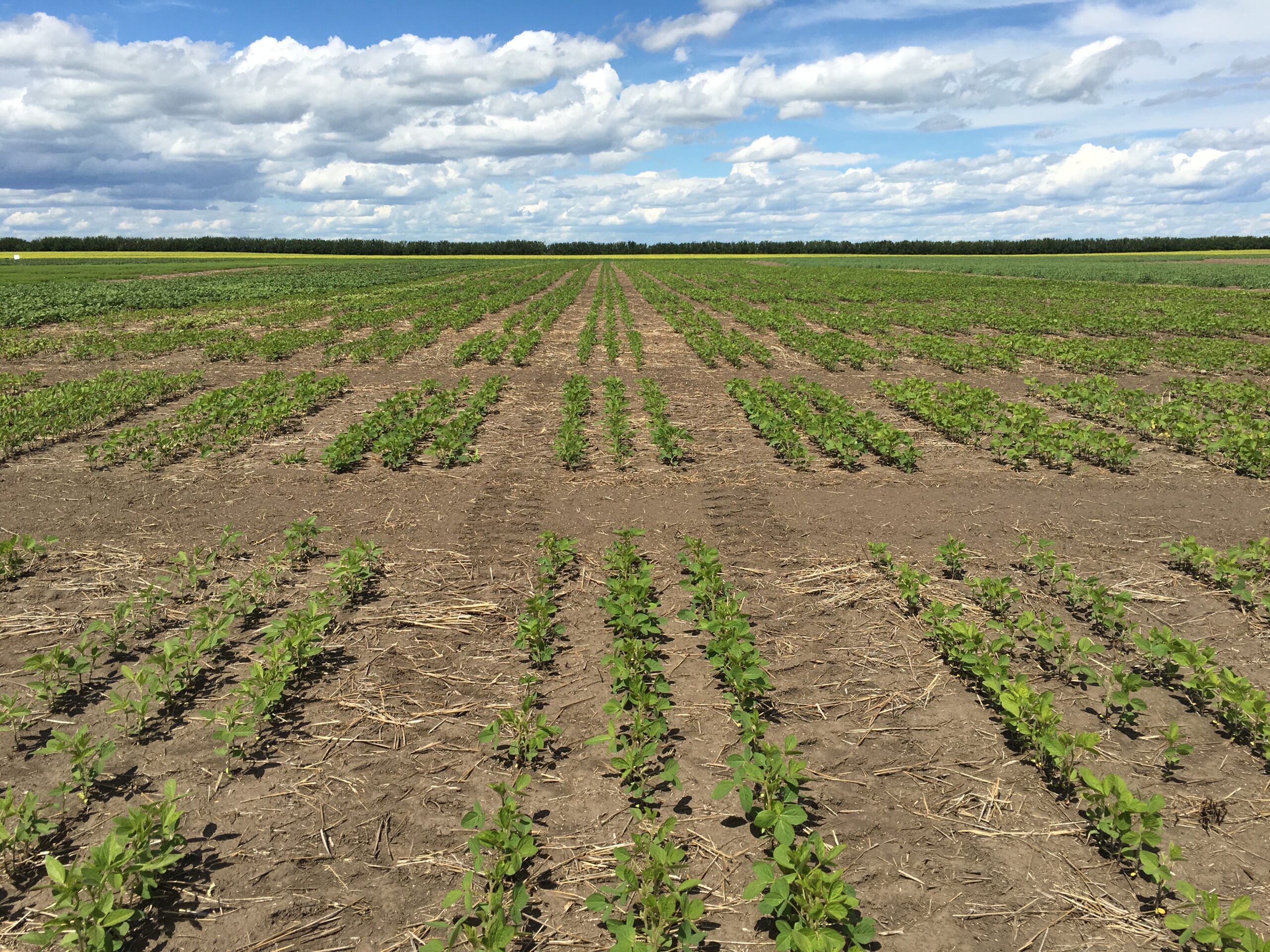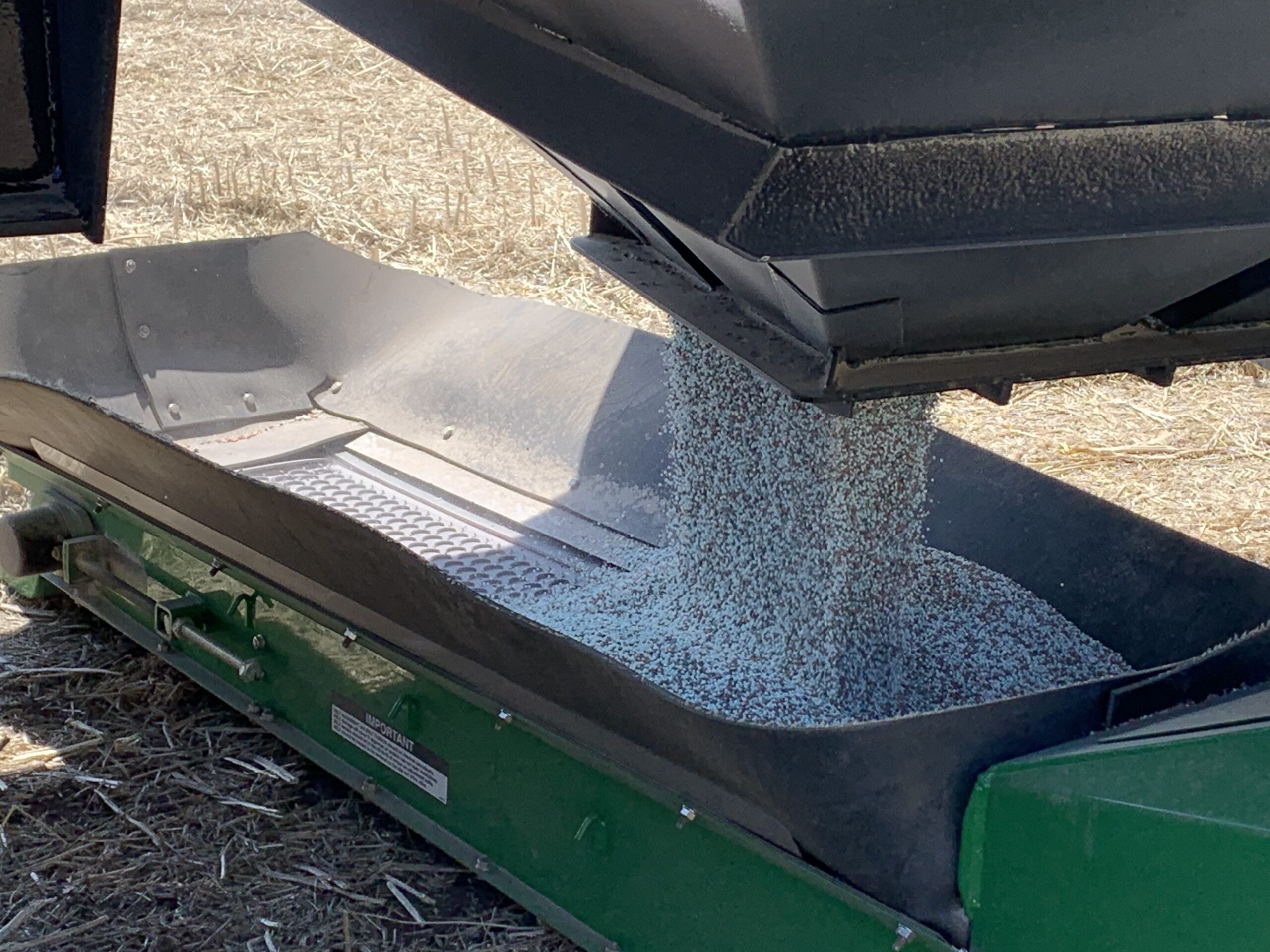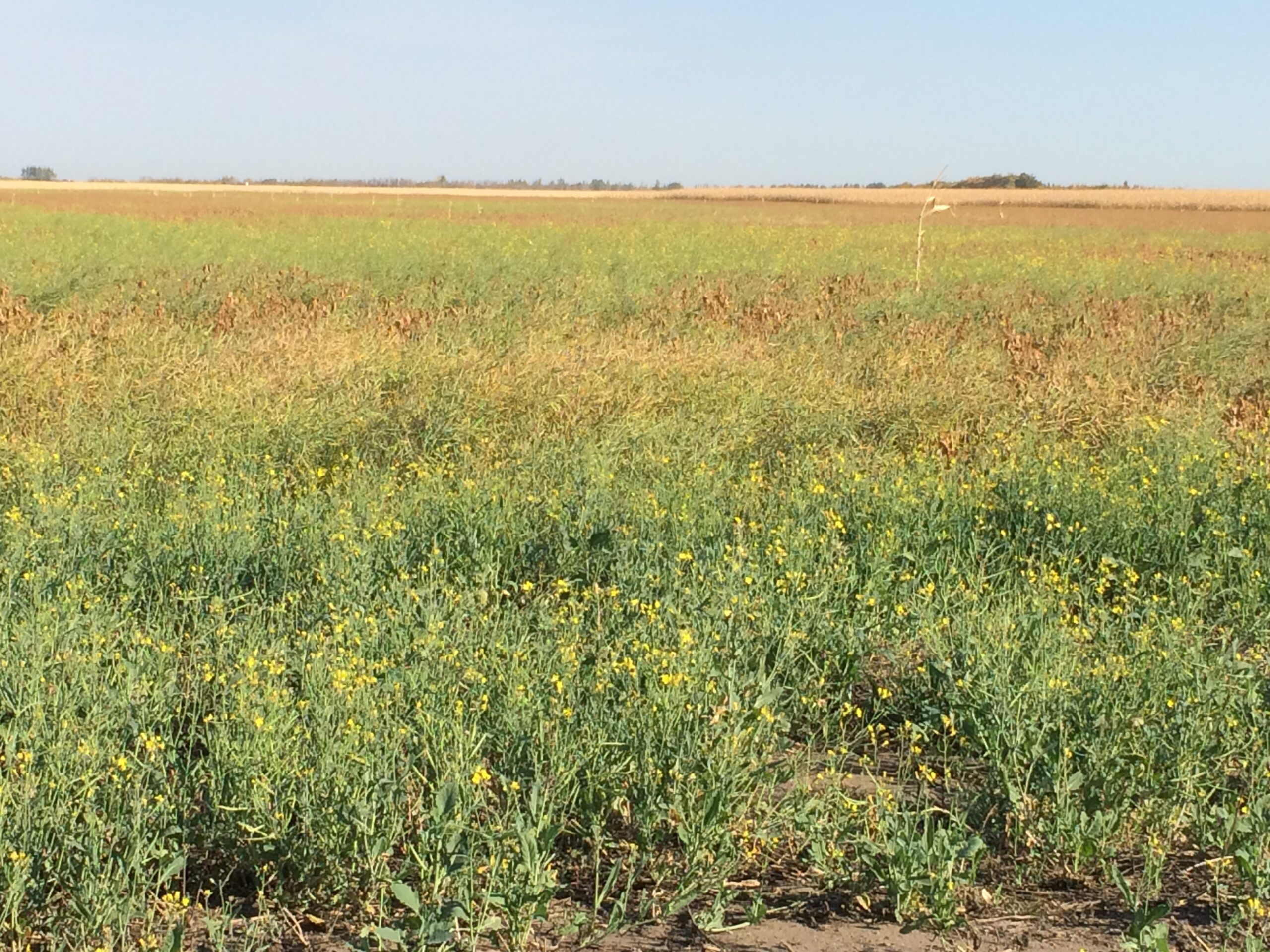Research Expert: Dr. Diane Knight
Introduction
Short-season soybean breeding programs in Western Canada have led to the introduction of soybeans into Saskatchewan and Manitoba, with soybean acres increasing from under 10,000 acres in 2011 to 1.5 million acres in 2022. One issue with these short-season varieties is that they have up to 10% lower seed protein content than long-season soybeans grown in Eastern Canada. Non-food grade soybeans need a minimum of 39% protein on a dry weight basis for export to China, and shipment rejection occurs at 38% protein. The reason for lower seed protein levels in these short-season varieties is unknown. One theory is that short-season soybeans do not fix nitrogen (N) as effectively as long-season soybeans. It has been suggested that short-season soybeans may not have time to move enough fixed N into the seed to reach adequate protein levels. Another hypothesis is that cool springtime prairie soils may delay soybean root development and colonization of N-fixing bacteria, resulting in lower rates of biological fixation (BNF). This research aimed to quantify biological nitrogen fixation in short-season soybeans to determine if reduced N fixation is related to low soybean seed protein levels in Western Canada.
Research Methodology
A comprehensive approach was adopted to accurately determine the connection between BNF and seed protein levels. Six different experiments were conducted, comparing a wide variety of soybean genotypes in low—and high-fertility soils, dry and moist soil conditions, and at various temperatures in growth chambers, followed by field-scale trials.
The greenhouse studies occurred at the University of Saskatchewan College of Agriculture and Bioresources greenhouses. Soils were collected in the spring of 2018 from a Saltcoats, Sask. farm in the moist black soil zone. Soils were dried and stored, so all greenhouse studies used the same soils. Field capacity (FC) was determined for each soil. Pots were then filled with 2.9 kg of dry soil, watered, and held at FC for seven days to allow the soil microbial population to equilibrate before seeding. The seed was treated with Vibrance® Maxx RFC and dried on seed overnight. Before seeding, the seed was dual-inoculated at recommended rates with commercial Bradyrhizobium japonicum as both liquid on the seed and granular inoculant placed in the soil. Three seeds were planted per pot at 2.5 cm depth and thinned to one plant per pot two weeks after emergence.
Experiment Methodologies & Key Findings
Study 1: Quantify BNF and total N uptake in short-season soybean varieties.
Methodology
To quantify BNF and total N uptake in the greenhouse, 15 varieties of short-season soybeans from 11 providers were grown in high and low-fertility soils at optimum water (80% of FC) and low water (50% of FC). The low fertility soil contained 2% OM, 3 lb N ac-1, 34 lb P2O5 ac-1, 420 lb K ac-1 and 104 lb S ac-1, and the higher fertility soil contained 4.5% OM, 20 lb N ac-1, 120 lb P2O5 ac-1, 720 lb K ac-1 and 320 lb S ac-1. Each variety was replicated five times, and hard red spring wheat was grown as a reference to calculate BNF.
After thinning the pots two weeks after emergence, 15N-labeled fertilizer was applied to the soil in the watering solution to enable the measurement of the percentage of N derived from the atmosphere (%Ndfa). In the optimum water treatments, pots dried to 65% FC before being rewatered to 80% and in the low water treatments, pots dried to 35% before being rewatered to 50%.
One pot from each variety was harvested when 80% of the varieties were flowering to collect and preserve nodules for analysis of Bradyrhizobium strain occupancy. At maturity, shoots of the remaining plants were cut off at the soil level and dried. The seed was separated from the rest of the crop residue, and each component was ground, weighed, and analyzed for 15N and total N. Seed yield, seed protein (%), %Ndfa, and N content derived from BNF were calculated and compared among the 15 genotypes under different water and soil fertility conditions.
15N Dilution Method
The 15N-dilution method for measuring N fixation relies on growing an N-fixing crop (e.g. soybean) and a non-N-fixing reference plant (hard red spring wheat) and supplying both with a small amount of 15N-labeled fertilizer. There are two N sources available to the non-fixing plant: 15N-labeled fertilizer and mineral N in the soil. The N-fixing plant has an additional source of N available to it: atmospheric N. When the soybean is fixing atmospheric N, the amount of 15N getting into the plant tissue is diluted by the atmospheric N. By comparing the 15N content of the N-fixing plant (which has been diluted by atmospheric N) to the non-fixing reference plant (which has the maximum amount of 15N uptake under the growing condition) the percentage of N fixed from the atmosphere can be calculated. The less 15N in the legume, the more N fixation has occurred.
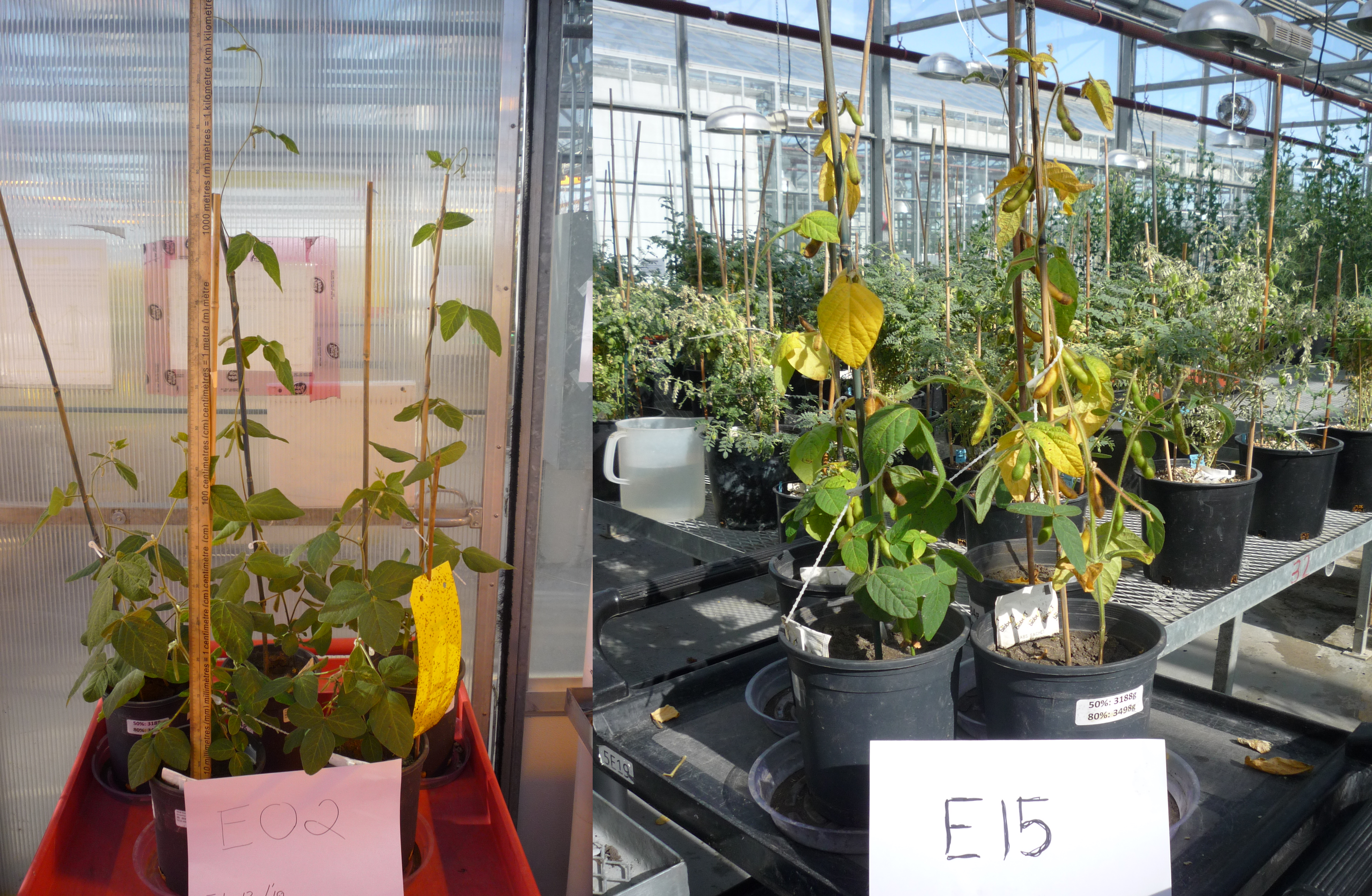
Photos: Darin Richman
Key Findings
No short-season soybean variety performed best in all the soil fertility and water conditions, which indicates that certain varieties were better adapted to certain conditions. Overall, soil water significantly impacted a variety’s performance more than soil fertility. Soybeans grown in low water conditions had 13% lower %Ndfa regardless of soil fertility (Table 1). Typically, %Ndfa increases with low soil N; however, low water likely limits BNF. Water did not impact seed protein the same as BNF; seed protein was 7.8% lower in the low fertility and low water conditions than the other three treatments, which were not statistically different (Table 1). Seed protein for a specific genotype varied widely depending on growing conditions, indicating conditions and genetics are both essential components of seed protein development.
Pearson correlations showed that %Ndfa correlated with yield (Table 2). This correlation indicates that BNF, and therefore N nutrition, drove yield. The strongest correlation was in the high water and high fertility treatment, likely because these plants grew the fastest, depleting soil N in the pots more quickly and triggering BNF. Seed protein negatively correlated with yield in the low fertility and low water treatment at -0.611 (Table 2), meaning that seed protein went down as yield went up when water and nutrients were limiting. There was no correlation between seed protein and %Ndfa for any soil conditions, indicating that BNF was not limiting seed protein content.
Table 1. %Ndfa and seed protein (%) for soybean genotypes grown in different soil condition combinations.
| Fertile | Fertile | Low fertility | Low fertility | |
| Parameter | High water | Low water | High water | Low water |
| %Ndfa | 81.7b | 71.3c | 85.9a | 69.8c |
| Seed protein (%) | 39.1a | 40.4a | 39.0a | 36.4b |
Table 2. Summary of Pearson correlations (r) between %Ndfa, seed protein, and yield from the greenhouse (Study 1) and field studies (Study 5).
| %Ndfa vs seed protein | Yield vs seed protein | Yield vs %Ndfa | |||
| Experiment | Conditions | Study No. | r value | r value | r value |
| Greenhouse | High fertility, high water | 1 | 0.063 | -0.277 | 0.833* |
| Greenhouse | High fertility, low water | 1 | 0.233 | 0.015 | 0.339 |
| Greenhouse | Low fertility, high water | 1 | -0.051 | -0.35 | 0.490* |
| Greenhouse | Low fertility, low water | 1 | -0.094 | -0.611* | 0.683* |
| Field – 2019 | Broderick | 5 | 0.221 | -0.251 | -0.251 |
| Field – 2020 | Saskatoon | 5 | 0.155 | -0.273 | 0.359 |
| Field – 2020 | Clavet | 5 | 0.163 | -0.580* | 0.04 |
| Field – 2019 | Floral | 5 | – | -0.327 | – |
| Field – 2019 | Kamsack | 5 | – | 0.660* | – |
| Field – 2019 | Rosthern | 5 | – | 0.938* | – |
Study 2: Determine nodule occupancy of introduced B. japonicum strain in soybeans.
Methodology
To determine the presence of inoculated Bradyrhizobia bacteria in soybean root nodules, soil from two fields in the moist Black soil zone, one with soybean history in 2015 and 2018 and one with no soybean history, were collected in October 2018. Two randomly selected varieties from the first experiment were used in this study. Pots were grown in the greenhouse with optimal water. Ten nodules were randomly selected from each plant at mid to late flowering, removed from the root systems, surface sterilized, and freeze-dried for processing. Nodules were analyzed by qPCR to determine the presence of the B. japonicum strain introduced with the inoculant.
Key Findings
The introduced B. japonicum strain was present in all root nodules in soil with and without soybean history. All plants had well-developed, pink-coloured nodules that appeared to be functioning.
Study 3: Determine N uptake rates at different development stages of short-season soybeans.
Methodology
The two soybean varieties used in Study 2 were replicated four times in the greenhouse with the following fertility treatments:
- No fertilizer N
- 250 kg N ha-1 (223 lb ac-1) at seeding
- 500 kg N ha-1 (446 lb ac-1) at seeding
- 250 kg N ha-1 over the season
- 500 kg N ha-1 over the season
Nitrogen applied over the duration of the study was matched to crop N demand: 10% applied at V2, 10% at V4, 20% at R1, 30% at R3 and 30% at R5. N content in the unfertilized treatment represented N acquired solely through BNF. Plants from each treatment were harvested at V1, R1, R3, and R5 stages, dried, and analyzed for N content.
Key Findings
This experiment aimed to determine if soybean can acquire adequate N through BNF by comparing soybean N uptake when fertilizer N was supplied at various growth stages to BNF alone. The two N fertilizer amounts used in the study represented adequate and excess N supply. Results showed that the N acquisition pattern was similar for the different N fertilizer rates and timing in the vegetative and early reproductive stages, with more significant variation in uptake during the late reproductive stages (R5 and R7) (Figure 1). When N was applied at seeding, the 250 kg N ha-1 treatment had the highest uptake, but when N was applied throughout the growing season, N uptake was highest with the 500 kg N ha-1 treatment. However, the actual N content was similar for these two treatments. N content in the unfertilized treatment, where BNF is the only N source, was comparable to the 250 kg N ha-1 rate applied throughout the growing period or the 500 kg N ha-1 applied at seeding for each growing stage. This result indicates that short-season soybeans can meet their N requirements through BNF.

Study 4: Determine the impact of low growing temperatures on BNF in short-season soybeans.
Methodology
Two soybean genotypes were grown in different temperature regimes in a growth chamber, which included:
- 15°C constant
- 25°C constant
- 15°C→25°C at late vegetative (V10)
- 15°C→25°C at mid-flower (R2)
- 15°C→25°C at pod fill (R5)
Treatments were replicated eight times for each genotype. At emergence, ten atom % 15N-urea was applied at 5.6 kg ha-1 (5 lb ac-1). When pots were moved to a different temperature, a subset of 4 plants per genotype were harvested. The remaining four plants per genotype were grown to maturity over 157 days, and shoots were harvested. After harvest, shoot tissues were dried, weighed, ground, and measured for 15N content and %N. Productivity (measured as dry weight), %Ndfa, amount of N in the shoot, and %N in the shoot were analyzed for the early harvested subset and the same measurements plus seed N and seed protein for those harvested at maturity.
Key Findings
Plants grown at the constant 25°C had the highest productivity in the shoot and seed, and dry matter decreased as the length of time growing at 15°C increased (Table 3). The plants grown at the constant 15°C and the group transferred to 25°C at R5 failed to mature and set seed and had significantly lower %Ndfa in the shoot than the other temperature regimes. Note that the shoot protein was higher when the plants were moved to the higher temperature at R5 than R2 because R5 was delayed in maturity, so the seed that was beginning to set remained with the shoots at harvest, boosting shoot protein. When the cool period extended into the early reproductive phase (R2), %Ndfa in the shoot and seed, and seed protein were not different from 25°C constant, indicating cool temperatures are not causing reduced BNF or seed protein. Cool spring conditions may delay soybean growth, but the delay is not because of reduced BNF.
Table 3. Productivity, %Ndfa, %N content in the shoot, and seed protein in soybean grown in different temperature regimes.
| Productivity (g/plant) | % Ndfa | % N (in shoot) or % protein (in seed) | ||||
| Treatment | Maturity | Maturity | Maturity | Maturity | Maturity | Maturity |
| shoot | Seed | shoot | Seed | shoot | Seed | |
| 15 °C constant | 1.96c | No seed | 26.4b | No seed | 2.17a | No seed |
| 25°C constant | 6.16a | 3.06a | 43.9a | 65.8a | 2.67a | 47.3a |
| 15/25 @ 10 | 4.73b | 2.54a | 40.6a | 46.5b | 2.32a | 40.4a |
| 15/25 @ R2 | 3.26b | 1.79b | 45.0a | 52.6ab | 1.27b | 39.7a |
| 15/25 @ R5 | 1.67c | No seed | 23.1b | No seed | 2.68a | No seed |
Study 5: Quantify BNF and determine nodule occupancy in short-season soybeans in the field.
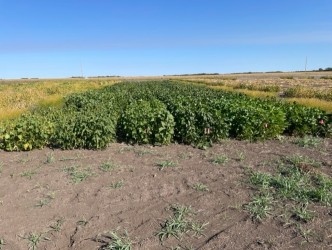
Photos: Darin Richman
Methodology
In 2019 and 2020, four replicates of 24 soybean genotypes (different from Study 1) were seeded in a randomized complete block design (RCBD). In 2019, four other sites were seeded: Broderick (irrigated), Floral, Rosthern, and Kamsack (dryland). In 2019, seeding was delayed until the last week of May due to inclement weather conditions. In 2020, plots were seeded at Saskatoon and Clavet. 15N urea fertilizer was applied after emergence in 1 m by 1 m microplots at Broderick in 2019 and Saskatoon and Clavet in 2020. Flax was seeded as the reference crop. Nodules were collected at mid-flowering to measure nodule occupancy. The 15N micro plots were hand harvested to separate seed and straw and measure yield, N uptake, protein, %Ndfa, and BNF-N. Outside of the 15N plots, yield, seed protein, and total N uptake were measured. Drought and COVID restrictions in 2020 limited this field trial in both years.
Key Findings
Seed protein was lower in the field trials than the greenhouse studies due to less-than-ideal growing conditions (Table 4). As mentioned previously, the marketing standard for protein is at least 39%. At Broderick in 2019, 14 of 24 genotypes were above 39%, whereas at Clavet and Saskatoon in 2020, only two of 24 and three of 24 had adequate seed protein. %Ndfa was similar but slightly lower in the field than for the growth chamber study at 64.4% (Broderick) to 75.4% (Clavet) versus 69.8% (low water, low fertility) to 85.9% (low fertility, high water). A slightly lower %Ndfa in the field is likely due to variability in moisture conditions.
In 2020, the Saskatoon site yielded 52% higher on average than Clavet. However, seed protein was similar, and BNF was 36% higher in Clavet. The Pearson correlations (Table 2) showed a significant negative correlation between yield and protein at Clavet, which was also seen in the growth chamber study. The highest protein genotypes yielded the lowest. At Kamsack and Rosthern, yield and seed protein were positively correlated. However, low seed production likely drove this correlation, as these were the lowest-yielding sites. There was no correlation between %Ndfa and seed protein at any of the 15N micro plots, evidence that BNF is not connected to low seed protein.
Table 4. Averages of all genotypes for each site-year with 15N microplots at Broderick, Clavet, and Saskatoon and regular plots at Floral, Kamsack, and Rosthern. Standard deviation indicates the level of variation between genotypes for a given parameter.
| Yield | N uptake | Protein | Ndfa | BNF-N | ||||||
| kg ha-1 | kg N ha-1 | % | % | kg N ha-1 | ||||||
| Site-Year | Mean | SD | Mean | SD | Mean | SD | Mean | SD | Mean | SD |
| Broderick 2019 | 2527 | 576 | 160 | 36 | 39.6 | 2.71 | 64.4 | 18.9 | 111 | 40 |
| Clavet 2020 | 2343 | 387 | 132 | 23 | 35.4 | 0.98 | 75.4 | 4.9 | 100 | 20 |
| Saskatoon 2020 | 3567 | 395 | 209 | 23 | 36.7 | 1.04 | 64.7 | 6.5 | 136 | 22 |
| Floral 2019 | 2631 | 281 | — | — | 43.4 | 2.26 | — | — | — | — |
| Kamsack 2019 | 2359 | 276 | — | — | 37.9 | 1.43 | — | — | — | — |
| Rosthern 2019 | 2024 | 364 | — | — | 38.8 | 1.49 | — | — | — | — |
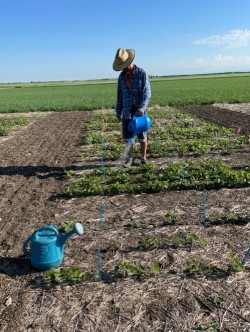
Photos: Darin Richman
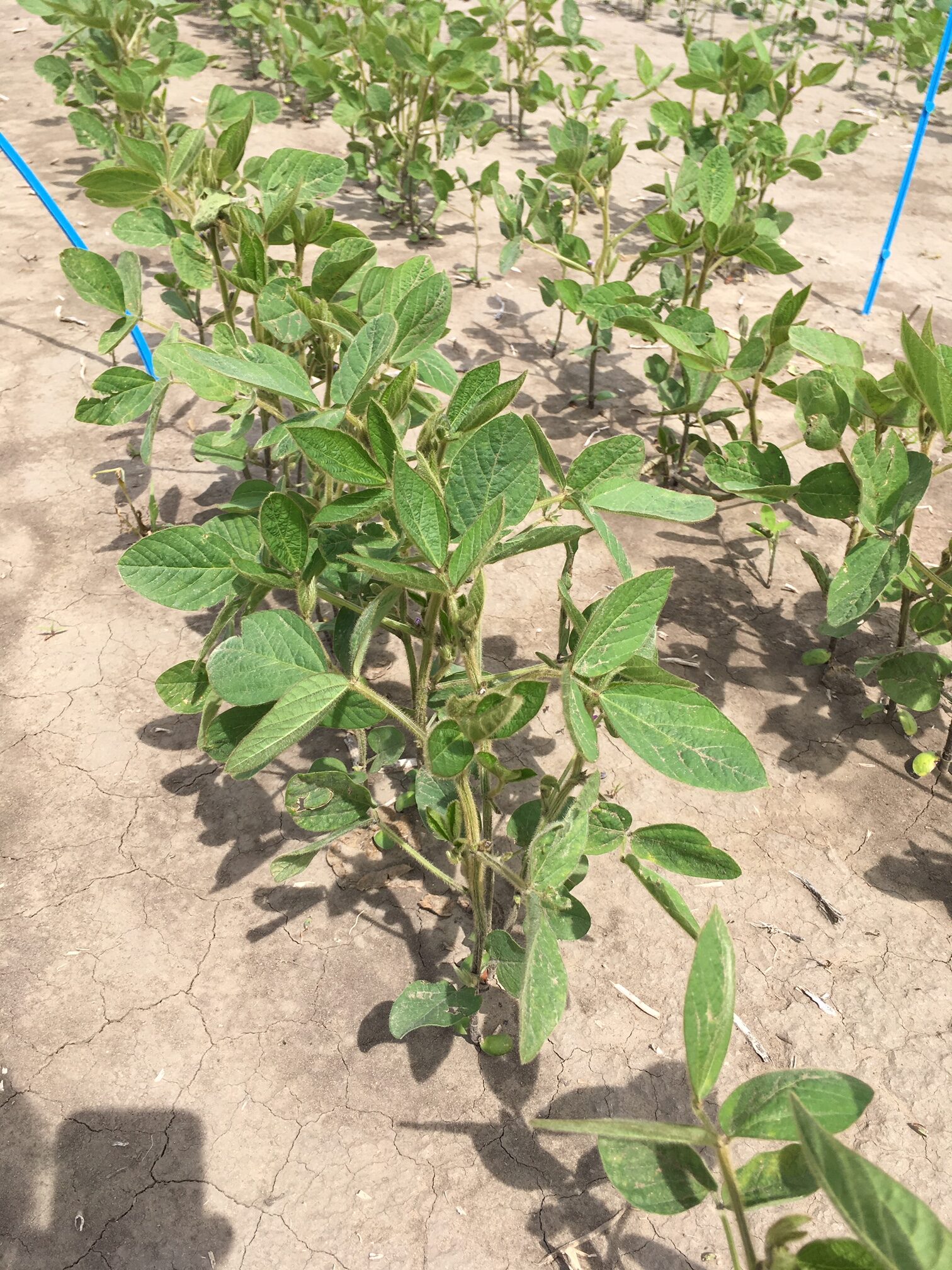
Photos: Darin Richman
Study 6: Evaluate the effect of cool spring-early summer temperatures on BNF levels in ultra-late seeded short-season soybeans grown in the field.
Methodology
To determine if avoiding cool spring temperatures would increase growth and BNF, 12 soybean genotypes and 12 reference flax plots were sown in Aberdeen, Sutherland, and Rosthern in the third week of June 2022. 1 m x 1 m 15N micro plots were established in each plot two weeks after emergence. The 15N fertilizer was applied with 7L of water. Due to dry conditions, plots were irrigated with an additional 7L of water to move the 15N urea into the soil and provide some moisture for growth. The 15N micro plots were hand-harvested the second week of September, noting the crop stage. The above-ground material was dried, the seed was separated from tissues, and each part was ground, weighed, and measured for BNF, %N in shoots, seed protein, and tissue N content.
Key Findings
Very late seeding resulted in yields that were 19% to 65% of the 2019 and 2020 soybean trials in Study 5. Because of the very late seeding, none of the varieties were expected to set seed, however, all did set a small amount. Seed protein was comparable but slightly lower than in study 5, at 36.7% to 38.8%, compared to 35.4% to 43.4%. BNF, however, was much lower in the late-seeded trials, at 18 to 22 kg N ha-1, compared to the spring-seeded soybeans, which were at 100 to 136 kg N ha-1. This result indicates that cool spring temperatures are not inhibiting BNF in the soybean varieties. The warmer temperatures and longer day length with the June seeding accelerated the time to seed set and reduced BNF. Seed protein was also not correlated to yield, %Ndfa, or amount of N fixed from BNF.
Table 5. Average of all genotypes for yield, seed protein, %Ndfa, and BNF-N at each site for very-late seeded soybean. Standard deviation indicates the level of variation between genotypes for a parameter.
| Yield | Seed Protein | Ndfa | BNF-N | |||||
| kg ha-1 | % | % | kg N ha-1 | |||||
| Site | Mean | SD | Mean | SD | Mean | SD | Mean | SD |
| Rosthern | 738 | 111 | 38.8 | 1.2 | 13.3 | 6 | 22.3 | 0.4 |
| Aberdeen | 851 | 94 | 36.7 | 0.8 | 48.8 | 3.3 | 17.6 | 0.3 |
| Sutherland | 911 | 55 | 38.3 | 1.1 | 50.1 | 2.7 | 20.7 | 0.3 |
Implications & Recommendations
This research aimed to investigate if biological nitrogen fixation (BNF) was inhibited in short-season soybeans and the cause of the low seed protein levels seen in Western Canada. There was no evidence from this research that BNF is inhibited and no correlation between low seed protein content and BNF in short-season soybean varieties grown in Saskatchewan.
Seed protein was affected by soil fertility and soil moisture. However, different soybean genotypes responded differently to these environmental restrictions. Low soil N fertility enhanced BNF, as observed in other research. However, BNF was impacted by soil fertility only when there was enough soil water. There was no connection between seed protein and the amount of N derived from the atmosphere (%Ndfa), regardless of soil fertility or moisture conditions. As well, genotypes with high seed protein content generally produced lower yields.
Poor inoculation success was not a cause of low seed protein. In the nodule occupancy experiments, the commercial B. japonicum inoculant effectively colonized roots. %Ndfa indicated good levels of BNF in the soybeans.
In the growth chamber experiments, sustained cool temperatures of 15°C throughout the season, or at least into later reproductive stages, impaired plant growth and BNF to a lesser degree. However, ultra-late seeding in the field to avoid cool spring temperatures resulted in a drop in plant productivity and decreased BNF compared to earlier seeding.
This study did not identify the cause of low seed protein in short-season soybeans grown in Western Canada. However, it did rule out the theory that BNF is inhibited and thus reduces soybean seed protein. Soil water and soil N fertility were the factors driving BNF, to a lesser degree. However, the various soybean genotypes responded differently to the changes in environmental conditions. Farmers growing well-inoculated short-season soybean varieties with adequate moisture will see adequate biological N fixation. More research is required to uncover the cause of low-seed protein.
